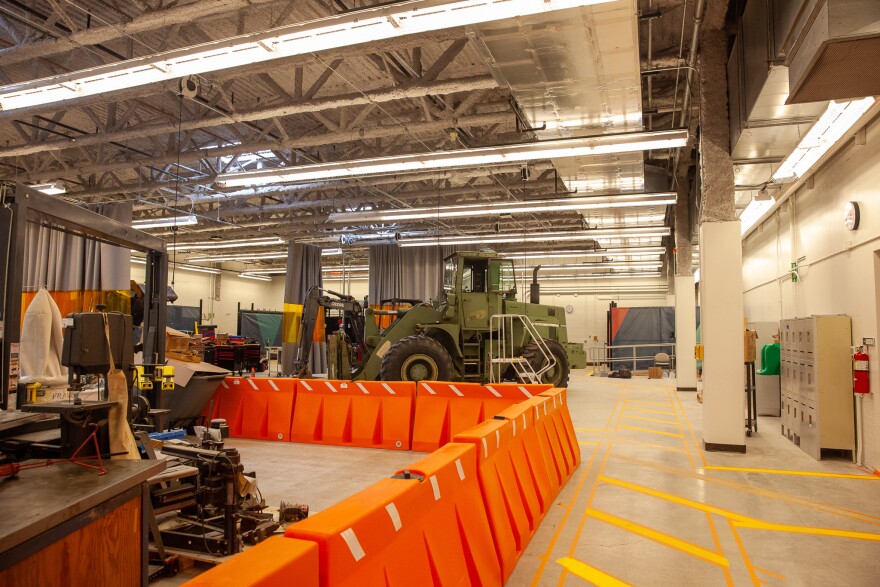The Bloomington Career Academy [BCA] is largely moved in at the Willie G. and Gloria Brown Education Center that District 87 purchased from State Farm in 2024.
There are 13 separate career programs currently offered by the BCA, with yearlong individual classes for students to take for high school and sometimes college credit. Bryce Hansen, director of the BCA, gave WGLT an updated tour of the new space during the first week of classes.
More than 1,000 students, from 17 different schools in McLean and surrounding counties, sent students to the BCA for this school year. Hansen said the enrollment number is more than 200 students higher than last school year.

“I think as we continue to grow in the space and take over more parts of the building, I think we'll have continued opportunities to grow and provide these opportunities to more kids,” said Hansen.
Healthcare and emergency services
Health Careers and Medical Terminology students earning dual credit from Heartland Community College have two former emergency room nurses as instructors.
“While we're learning cardiology, we get to watch a Zoom and participate in an actual live open-heart surgery that's occurring right then,” said Hansen. “And then you type in questions into the chat box, and then the surgeon reads them and then answers the questions.”
“We did one a couple years ago and they were taking this vein out of this lady's leg to put in her heart. And so my question to the surgeon is like, ‘Doesn't she need that vein in her leg?’ And the surgeon, a couple minutes later, was like, no, actually the body will reroute the blood in a couple days,” said Hansen.

The CNA program has the largest enrollment at the BCA at about 150 students. Those students have two new labs set up similar to real-world hospital rooms. Hansen said the labs give students some practice before they move to Westminster Village in Bloomington that serves as a clinical site for students.
Seniors in the Criminal Justice and Law Enforcement program are able to earn an emergency telecommunicator certificate after a 10-week course. The option was added to the BCA a few years ago and students who earned it have been able to work for the City of Bloomington.
“EMS dispatch actually sends an instructor here to us, teaches the kids in our facility, and then when they finish that, they're able to go start for the City of Bloomington,” said Hansen. “They do tuition reimbursement, health benefits, things like that. So it's been a really great opportunity. We've sent several kids through that have gone on to work EMS dispatch.”
Culinary arts
Existing infrastructure from when State Farm served food from kitchens on-site will now be used by students in the Culinary Arts program. What used to be an employee cafeteria is now a classroom space. The adjacent kitchen area is not yet finished but will be used by students to put their lessons to the test.

“There's probably five times as much space here as I had before,” said Carrie Webster, the teacher for the course. “We had 16 students all crammed in a room trying to cook. So yeah, spreading the kids out, having more space, is going to be huge.”
There are two separate kitchen areas that will be used to differentiate between first and second-year students. First-year students will have individual cook stations and be more heavily supervised by an instructor. Second-year students will work in a galley-style kitchen — a narrower and more compact space that requires a bit less supervision.
“They know the deal a little bit more, most of them have some more industry experience working in restaurants, things like that,” said Hansen. “So they still need supervision, they still need guidance, but it's a little less hands-on."
Many lessons from Culinary Arts may ring a bell to those who have taken a family and consumer science [FACS] class. The difference is the pace of the course.
“When I come into these classrooms and visit, the students are friendly, but usually they don't have a lot of time to chat with me. They’ve got their timelines they have to meet,” said Hansen.
Hansen added the class will give the chance for a student-run cafeteria a few times a month in the future. Fundraisers are also on the menu, much like students did in the spring semester last school year.
Construction, cars and welding
Many trades and trades-adjacent courses will have several equipment additions and upgrades. Hansen said they were possible because of the extra space the new building provides.
A competitive grant awarded from the state provided funding for an off-campus CDL trucking program through Heartland, in partnership with the Nussbaum Trucking Academy. The grant also paid for several pieces of heavy machinery, including a wheel loader, forklift and excavator.

“It gives kids the opportunity to learn how to operate and practice with those pieces of equipment, as well as work on them and maintain them,” said Hansen.
Students will use heavy equipment simulators to practice before they operate the new machinery.
A new welding lab was paid for by a grant from the Illinois Department of Commerce and Economic Opportunity, in partnership with Heartland and Rivian.
Previously, welding classes were held at Heartland’s welding lab, which provided a challenge because some school districts could not provide transportation to Heartland’s campus rather than the BCA campus. That meant kids without a ride were out of luck.
“This is part of a manufacturing pathway that we're working on with them, really to kind of help get those skilled trades and skilled technicians in these different fields,” said Hansen. “The machines are the same ones they'll see at Heartland, so if they get dual credit in our welding program and they want to finish their associate's out at Heartland, they'll be familiar with the machine.”


